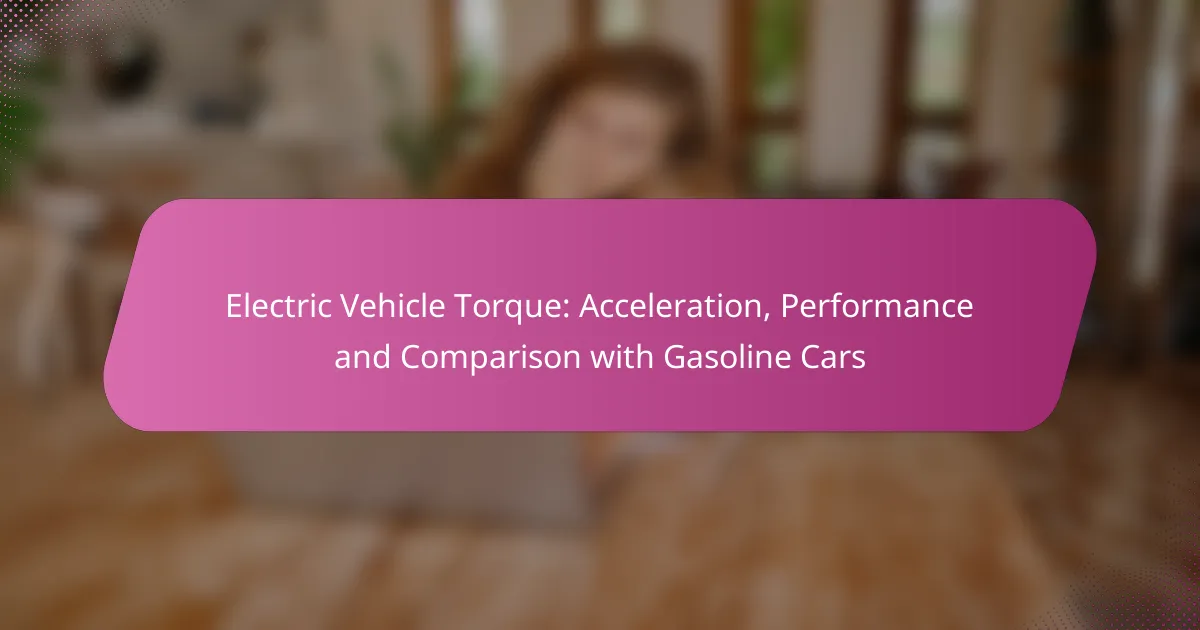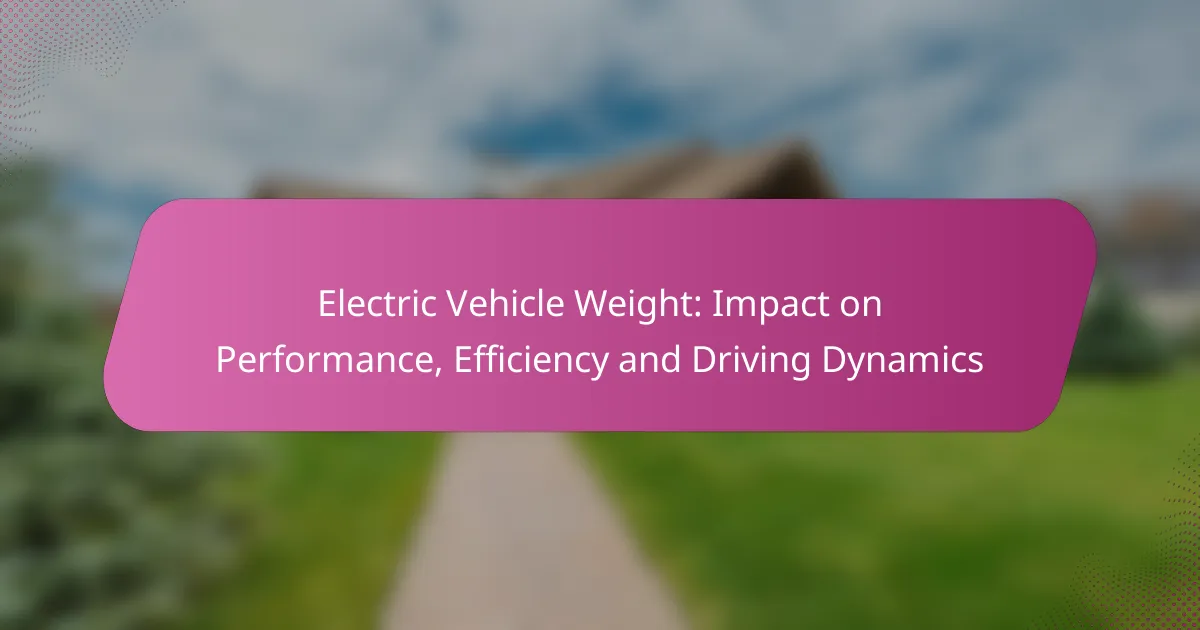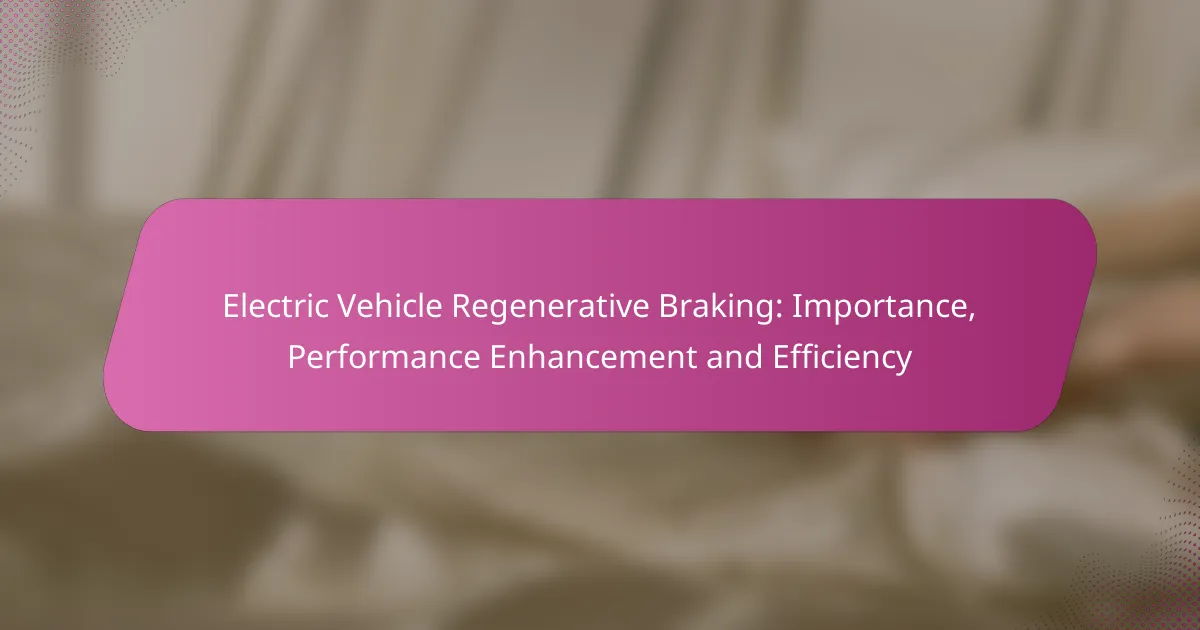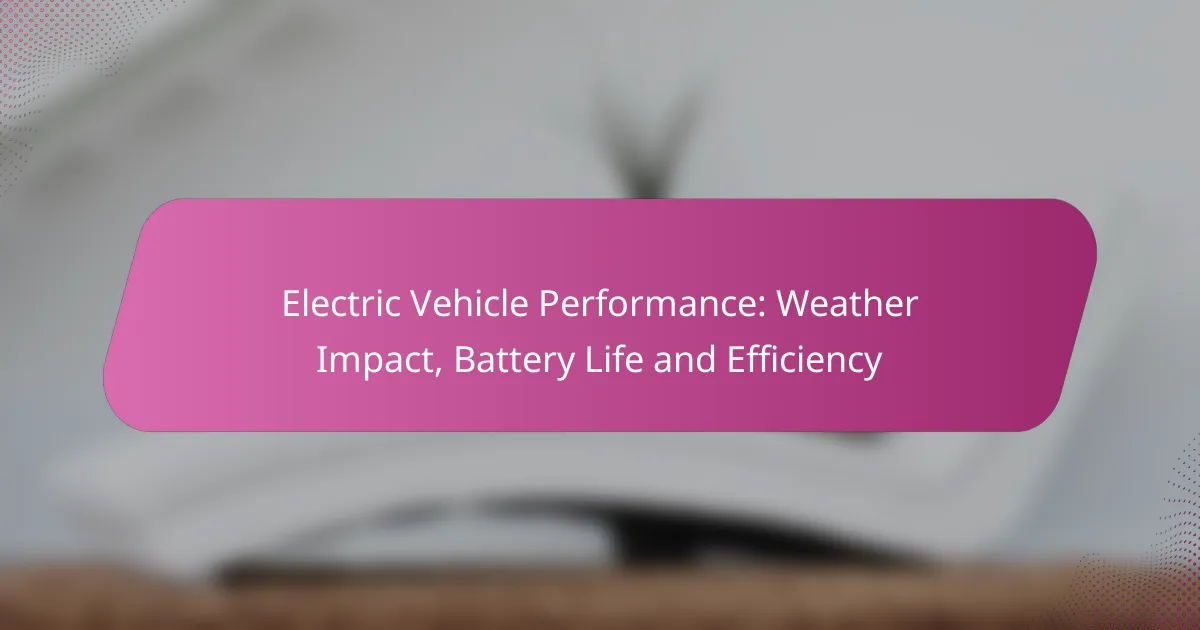Electric vehicles (EVs) are revolutionizing the driving experience with their remarkable torque characteristics, which provide instant acceleration at any speed. This immediate torque availability allows EVs to achieve rapid starts and smooth power delivery, often outperforming gasoline cars in terms of acceleration and responsiveness. As a result, EVs not only enhance driving performance but also offer a more efficient energy use compared to traditional vehicles.
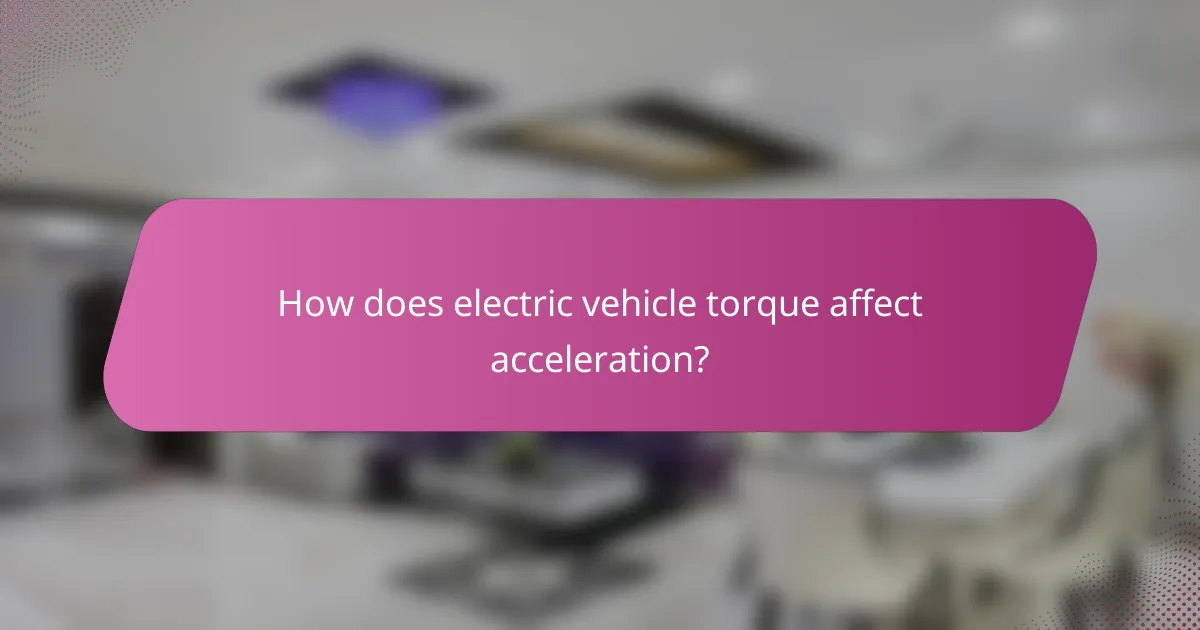
How does electric vehicle torque affect acceleration?
Electric vehicle torque significantly enhances acceleration due to its instant availability at any speed. This characteristic allows EVs to achieve rapid starts and smooth acceleration, making them feel more responsive compared to traditional vehicles.
Instant torque delivery
Electric vehicles provide instant torque delivery, meaning they can access maximum torque immediately upon acceleration. This results in a seamless and powerful driving experience, allowing drivers to accelerate quickly without the lag often associated with gasoline engines.
This immediate response is particularly advantageous in urban driving conditions, where quick starts and stops are common. The ability to deliver torque instantly can make navigating traffic much more efficient.
Comparison with gasoline torque
In contrast to electric vehicles, gasoline engines typically produce torque at higher RPMs, resulting in a delay before reaching peak performance. This means that while gasoline cars can be powerful, they often require more time to build up speed compared to their electric counterparts.
For example, a gasoline engine might need to rev up to several thousand RPMs to deliver its maximum torque, while an electric motor can provide its full torque from a standstill. This fundamental difference in torque delivery contributes to the overall performance gap between electric and gasoline vehicles.
Impact on 0-60 mph times
The instant torque of electric vehicles often translates to impressive 0-60 mph times, frequently outperforming gasoline cars in this metric. Many electric models can achieve this benchmark in under four seconds, while high-performance gasoline vehicles may take longer, depending on engine specifications.
For instance, a typical electric sedan might reach 60 mph in the low threes to mid-fours seconds, while a comparable gasoline sedan could take around five to six seconds. This acceleration advantage is a key selling point for many consumers considering an electric vehicle.

What is the performance of electric vehicles compared to gasoline cars?
Electric vehicles (EVs) generally offer superior performance in terms of acceleration and driving experience compared to gasoline cars. While top speeds may vary, EVs excel in quick starts and smooth power delivery, making them competitive in various driving conditions.
Top speed differences
Top speed is often a critical factor for performance enthusiasts. Many electric vehicles can reach speeds between 150 to 200 km/h, while high-performance gasoline cars can exceed 200 km/h. However, the practical top speed for everyday driving is often limited by legal regulations and safety considerations.
It’s essential to note that while EVs may have lower top speeds, their acceleration capabilities often compensate for this in real-world driving scenarios. The focus on efficiency in EV design means that many prioritize quick acceleration over maximum speed.
Acceleration metrics
Electric vehicles typically achieve impressive acceleration due to their instant torque delivery. Many EVs can go from 0 to 100 km/h in under 5 seconds, with some high-performance models achieving this in just a few seconds. In contrast, gasoline vehicles often take longer, usually ranging from 5 to 8 seconds for similar performance levels.
This rapid acceleration is a significant advantage for EVs, especially in urban environments where quick starts can enhance driving experience and safety. The immediate power response allows drivers to merge and overtake with confidence.
Driving experience
The driving experience in electric vehicles is often characterized by smoothness and quiet operation. EVs provide a unique sensation of acceleration without the noise and vibration associated with gasoline engines. This can lead to a more comfortable ride, especially in stop-and-go traffic.
Additionally, many EVs come equipped with advanced technology features that enhance the driving experience, such as regenerative braking and sophisticated infotainment systems. These features can improve overall vehicle control and efficiency, making EVs appealing for both daily commutes and long drives.
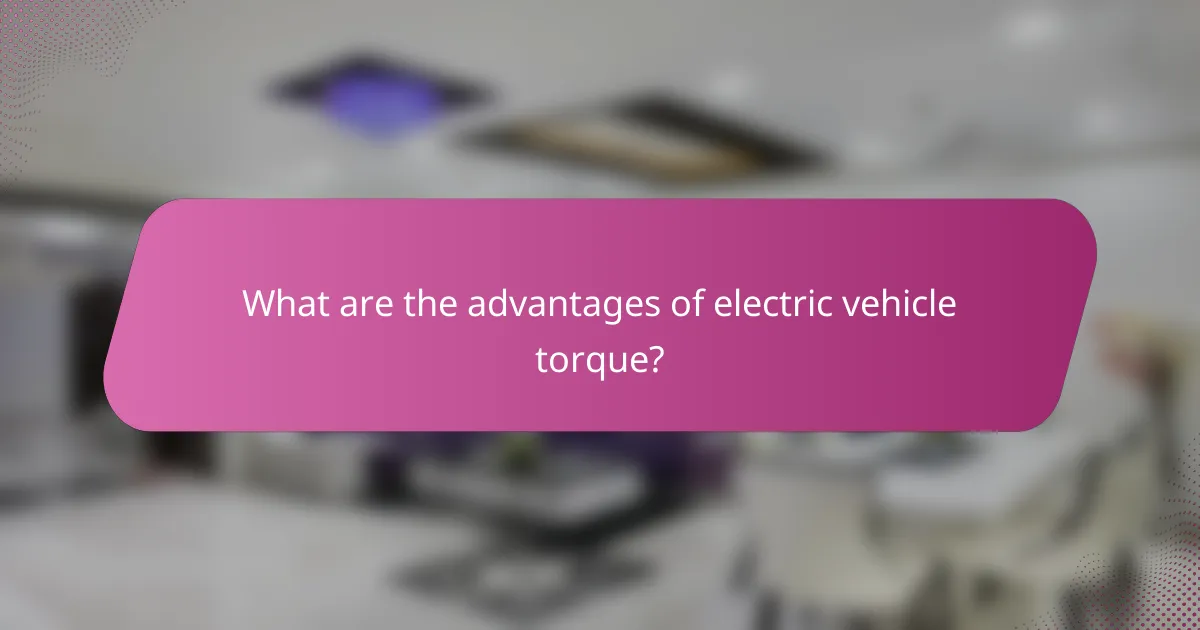
What are the advantages of electric vehicle torque?
Electric vehicles (EVs) offer several advantages in torque that enhance acceleration and overall performance compared to gasoline cars. The immediate availability of torque in EVs leads to quicker starts and smoother acceleration, making them highly efficient in energy use.
Efficiency in energy use
Electric vehicles are designed to convert a higher percentage of electrical energy from the grid to power at the wheels compared to gasoline engines. While traditional combustion engines typically convert only about 20-30% of the fuel’s energy into movement, EVs can achieve efficiencies of 60-80% or more.
This efficiency translates into better mileage per charge, allowing drivers to travel further on less energy. For instance, many modern EVs can cover over 4-5 miles per kilowatt-hour (kWh), making them more cost-effective in terms of energy consumption.
Reduced maintenance costs
Electric vehicles generally require less maintenance than gasoline cars due to fewer moving parts and no need for oil changes. The absence of complex components like transmissions and exhaust systems reduces the likelihood of mechanical failures, leading to lower long-term costs.
Moreover, regenerative braking systems in EVs help extend the lifespan of brake components by using the electric motor to slow the vehicle, which minimizes wear on brake pads. This can result in savings of hundreds of dollars over the vehicle’s lifetime.
Environmental benefits
Electric vehicles contribute to reduced greenhouse gas emissions, especially when charged from renewable energy sources. Unlike gasoline cars, which emit carbon dioxide and other pollutants, EVs produce zero tailpipe emissions, significantly improving air quality in urban areas.
Additionally, as more countries implement stricter emissions regulations and promote renewable energy, the environmental advantages of EVs are expected to increase. Transitioning to electric vehicles is a crucial step toward achieving sustainability goals and combating climate change.
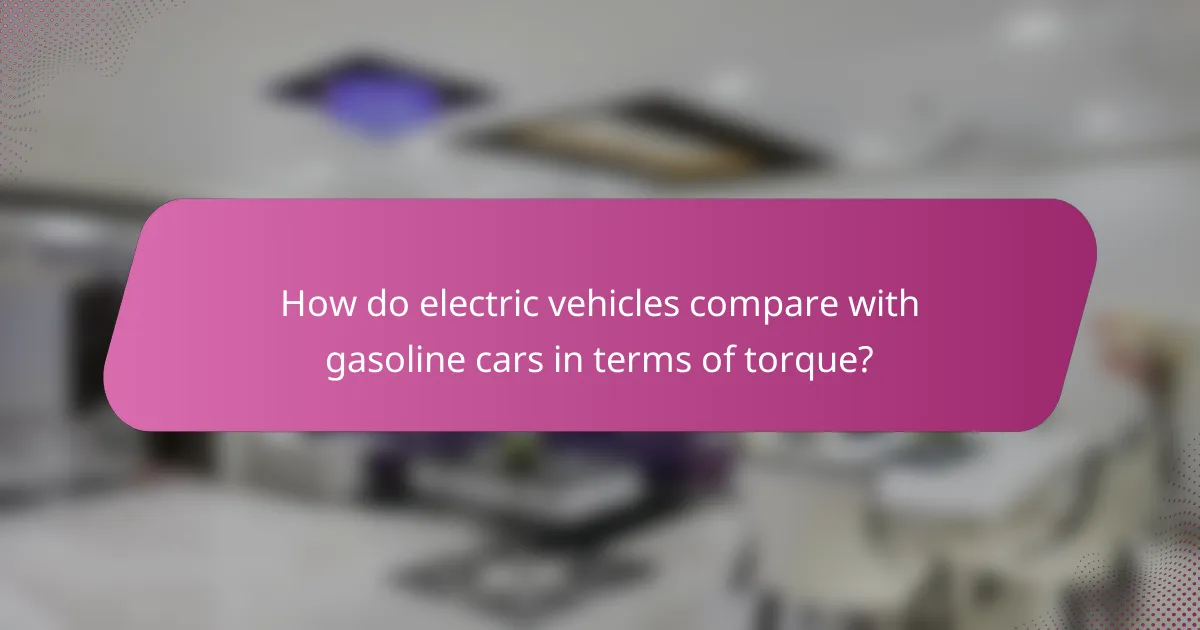
How do electric vehicles compare with gasoline cars in terms of torque?
Electric vehicles (EVs) generally provide higher torque than gasoline cars, resulting in quicker acceleration and improved performance. This is due to the instant torque delivery characteristic of electric motors, which allows for rapid power application compared to the gradual build-up in traditional combustion engines.
Torque characteristics of Tesla Model 3
The Tesla Model 3 is known for its impressive torque, with figures often exceeding 400 Nm across its variants. This high torque allows the Model 3 to accelerate from 0 to 60 mph in as little as 3.1 seconds, showcasing its performance capabilities. The electric powertrain delivers this torque instantly, providing a thrilling driving experience.
Additionally, the Model 3’s dual-motor all-wheel-drive system enhances traction, enabling better handling and stability during acceleration. This feature is particularly beneficial in varying weather conditions, making the Model 3 a versatile choice for performance enthusiasts.
Torque characteristics of Ford Mustang
The Ford Mustang, particularly in its EcoBoost and V8 variants, offers competitive torque figures ranging from around 350 Nm to over 600 Nm. This torque is delivered in a more traditional manner, with the turbocharged engines providing a strong mid-range pull, while the V8 engines deliver power at higher RPMs. This results in a different driving feel compared to EVs.
While the Mustang provides exhilarating acceleration, it typically requires more time to reach peak torque compared to electric vehicles. This characteristic can affect the overall responsiveness, especially during quick starts or overtaking maneuvers.
Torque delivery in hybrid vehicles
Hybrid vehicles combine internal combustion engines with electric motors, resulting in a unique torque delivery system. The electric motor provides instant torque, which can enhance acceleration from a standstill, while the gasoline engine contributes additional power at higher speeds. This dual approach allows hybrids to achieve better fuel efficiency without sacrificing performance.
For example, many hybrids can achieve torque figures similar to conventional gasoline cars, but with the added benefit of electric torque for improved responsiveness. However, the overall performance may still lag behind fully electric vehicles, particularly in terms of instantaneous acceleration.
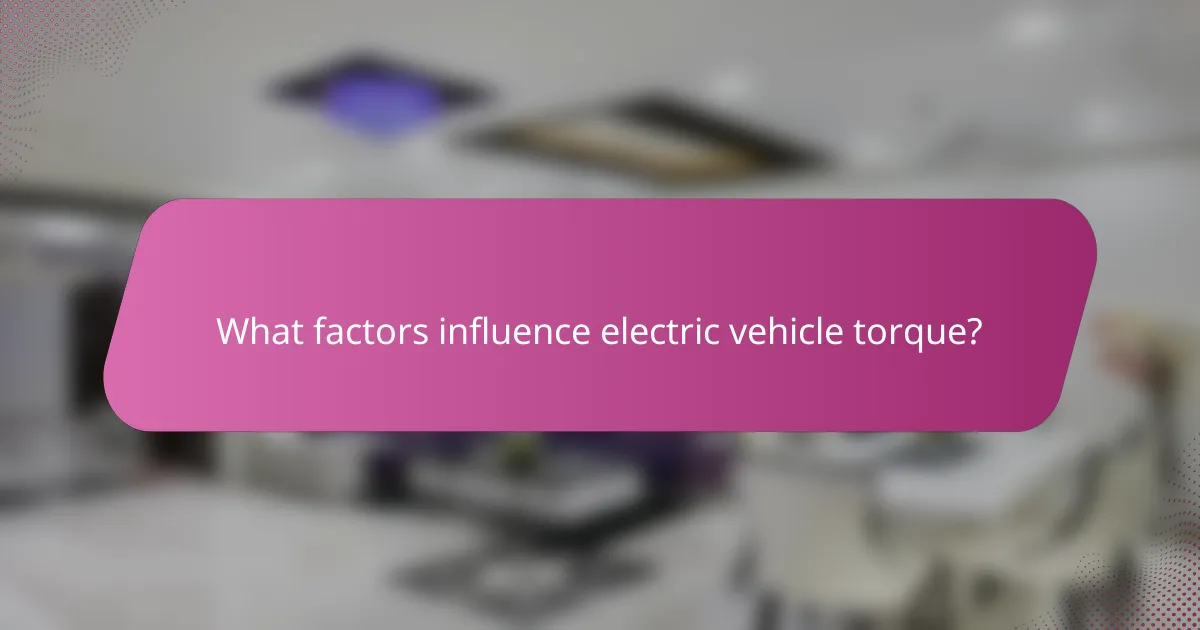
What factors influence electric vehicle torque?
Electric vehicle torque is primarily influenced by motor design, battery performance, and weight distribution. These factors determine how quickly and effectively an electric vehicle can accelerate compared to traditional gasoline cars.
Motor design and specifications
The design and specifications of an electric motor play a crucial role in determining torque output. Motors with higher power ratings and better efficiency can deliver more torque at lower speeds, allowing for quicker acceleration. For example, a well-designed permanent magnet motor can provide immediate torque response, enhancing performance.
In addition, the number of windings and the type of materials used in the motor can affect its overall torque characteristics. Motors designed for performance typically have a higher torque-to-weight ratio, which is essential for achieving rapid acceleration.
Battery capacity and performance
Battery capacity directly impacts the torque available to an electric vehicle. A higher capacity battery can supply more energy to the motor, enabling sustained high torque output during acceleration. Performance metrics such as discharge rates and thermal management also play a significant role in maintaining optimal torque levels.
For instance, lithium-ion batteries are commonly used in electric vehicles due to their ability to deliver high current quickly, which is essential for achieving strong acceleration. Ensuring that the battery can handle the demands of the motor is critical for maximizing performance.
Weight distribution
Weight distribution affects how torque is translated into acceleration. An electric vehicle with a low center of gravity and balanced weight distribution can achieve better traction, allowing for more effective torque application. This is particularly important when accelerating from a standstill or during cornering.
For optimal performance, manufacturers often design electric vehicles with batteries placed low in the chassis, which helps lower the center of gravity. This design choice enhances stability and improves the overall driving experience, making the most of the available torque.
